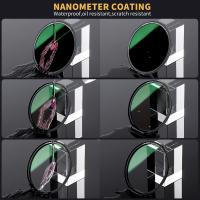Smallest Thing We Can See With A Microscope ?
The smallest thing we can see with a microscope depends on the type of microscope being used. With a light microscope, the smallest thing that can be seen is around 200 nanometers, which is the size of a small bacterium. However, with an electron microscope, which uses a beam of electrons instead of light, we can see objects as small as a few picometers, which is the size of an atom. This allows us to see the fine details of cells, viruses, and even individual molecules. The development of advanced microscopy techniques has revolutionized our understanding of the microscopic world and has led to many important discoveries in fields such as biology, chemistry, and materials science.
1、 Atomic scale
The smallest thing we can see with a microscope is at the atomic scale. At this scale, we can observe individual atoms and their interactions with each other. However, the ability to see atoms with a microscope is limited by the wavelength of the light used to observe them. The wavelength of visible light is too large to resolve individual atoms, so scientists use electron microscopes to observe them.
In recent years, advancements in technology have allowed scientists to push the limits of what we can see with a microscope. For example, the development of aberration-corrected electron microscopes has allowed for higher resolution imaging of atomic structures. Additionally, the use of cryogenic electron microscopy has enabled the imaging of biological molecules at near-atomic resolution.
Despite these advancements, there is still much to learn about the atomic scale. For example, scientists are still working to understand the behavior of individual atoms and how they interact with each other. Additionally, there is ongoing research into the development of new microscopy techniques that could further expand our ability to observe the atomic world.
Overall, while the atomic scale represents the smallest thing we can see with a microscope, ongoing advancements in technology and research continue to push the boundaries of what we can observe and understand at this scale.

2、 Molecular scale
The smallest thing we can see with a microscope is at the molecular scale. A molecule is the smallest unit of a substance that retains its chemical properties, and it is composed of atoms bonded together. The size of a molecule can vary depending on the number of atoms it contains and the type of atoms involved.
With the advancement of technology, scientists have been able to observe and manipulate individual molecules using specialized microscopes such as the scanning tunneling microscope (STM) and the atomic force microscope (AFM). These microscopes use a tiny probe to scan the surface of a sample and create an image of the molecules present.
However, even with these advanced microscopes, there are limitations to what we can see. The Heisenberg uncertainty principle states that it is impossible to simultaneously determine the position and momentum of a particle, which includes molecules. This means that there is a fundamental limit to the resolution of any microscope, and we may never be able to see individual atoms within a molecule.
Despite these limitations, the ability to observe and manipulate molecules has revolutionized fields such as materials science, nanotechnology, and biotechnology. By understanding the behavior of molecules at the molecular scale, scientists can design new materials with specific properties, develop new drugs, and create more efficient energy sources.

3、 Nanoscale
The smallest thing we can see with a microscope is on the nanoscale. Nanoscale refers to objects that are between 1 and 100 nanometers in size. To put this into perspective, a human hair is about 100,000 nanometers in diameter.
With the advancement of technology, scientists have been able to observe and manipulate objects on the nanoscale. This has led to the development of nanotechnology, which has numerous applications in fields such as medicine, electronics, and energy.
However, there is ongoing debate about whether there is a limit to how small we can see with a microscope. The current limit is around 0.5 nanometers, which is the size of a small molecule. Some scientists believe that it may be possible to see even smaller objects with the development of new technologies, such as the use of graphene-based microscopes.
Regardless of the current limit, the ability to observe and manipulate objects on the nanoscale has opened up new avenues for scientific research and technological innovation. It is an exciting time for the field of nanotechnology, and we can expect to see even more advancements in the future.

4、 Subcellular scale
The smallest thing we can see with a microscope is at the subcellular scale. This includes structures such as organelles, which are the specialized compartments within cells that perform specific functions. Examples of organelles include the nucleus, mitochondria, and ribosomes. These structures are typically only a few micrometers in size and can be visualized using light microscopy or electron microscopy.
However, recent advances in microscopy techniques have allowed scientists to see even smaller structures within cells. For example, super-resolution microscopy techniques such as stimulated emission depletion (STED) microscopy and structured illumination microscopy (SIM) can achieve resolutions of up to 10 nanometers, allowing researchers to visualize individual molecules and protein complexes within cells.
Furthermore, cryo-electron microscopy (cryo-EM) has revolutionized the field of structural biology by allowing researchers to determine the three-dimensional structures of proteins and other biomolecules at near-atomic resolution. This technique involves freezing samples in liquid nitrogen and imaging them using an electron microscope, which can reveal the intricate details of molecular structures.
Overall, while the subcellular scale remains the smallest thing we can see with a microscope, advances in microscopy techniques continue to push the boundaries of what we can visualize and understand about the complex structures and processes within cells.
































There are no comments for this blog.